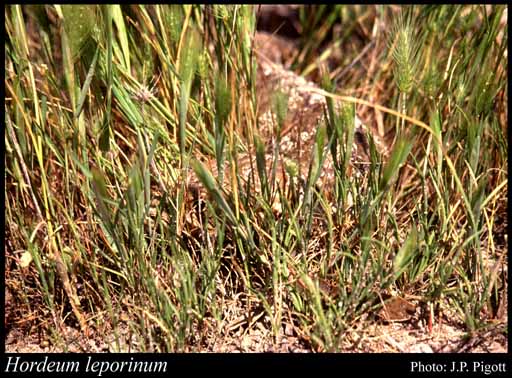- Reference
- Linnaea 9:133 (1834)
- Conservation Code
- Not threatened
- Naturalised Status
- Alien to Western Australia
- Name Status
- Current
Tufted annual, grass-like or herb, 0.1-0.4 m high. Fl. green-cream, Sep to Oct. White, grey or red clayey sand, sandy loam, clay.

Distribution
- IBRA Regions
- Avon Wheatbelt, Carnarvon, Coolgardie, Esperance Plains, Geraldton Sandplains, Jarrah Forest, Little Sandy Desert, Mallee, Murchison, Swan Coastal Plain, Warren, Yalgoo.
- IBRA Subregions
- Eastern Goldfield, Eastern Mallee, Eastern Murchison, Edel, Fitzgerald, Geraldton Hills, Katanning, Lesueur Sandplain, Mardabilla, Merredin, Northern Jarrah Forest, Perth, Recherche, Rudall, Southern Cross, Southern Jarrah Forest, Warren, Western Mallee, Wooramel.
- IMCRA Regions
- Abrolhos Islands, Central West Coast, Leeuwin-Naturaliste, Shark Bay, WA South Coast.
- Local Government Areas (LGAs)
- Albany, Busselton, Canning, Chapman Valley, Cockburn, Collie, Coorow, Corrigin, Dandaragan, Denmark, East Pilbara, Esperance, Gingin, Gnowangerup, Goomalling, Greater Geraldton, Joondalup, Kalgoorlie-Boulder, Lake Grace, Manjimup, Melville, Menzies, Moora, Narembeen, Narrogin, Nedlands, Northam, Northampton, Perth, Pingelly, Plantagenet, Quairading, Ravensthorpe, Rockingham, Shark Bay, South Perth, Stirling, Swan, Three Springs, Waroona, West Arthur, Wongan-Ballidu, Yilgarn, York.
Management Notes (for the Swan NRM Region)
Alternative Names. Wild barley, mouse barley.
General Biology. Growth form. Grass. Life form. Annual, caespitose. Reproduction. Seed. Dispersal. Mammals (on fur). Photosynthetic Pathway. C3. Toxicity. Seed can be fatal to lambs, awns on mature plants can cause injury to grazing animals. Seedbank persistence. 2 years.
Notes. Naturalised in North and South America and New Zealand. Dominates other native perennial grasses at high nturient levels. Grows on a range of soil types and tolerates very high nutrient levels. Produces prolific seed. Capable of germinating early and rapidly. Seeds lodge in animal fur/hair/wool and may be transported large distances. Smoke can stimulate seedling emergence. Known to have herbicide resistance.
Additional information. Origin. Europe, northern Africa, western Asia. History of use/introduction. Contaminated seed, hay and wool.
Suggested method of management and control. Prevent seed set. Hand pull or spray with Fusilade® Forte 16 ml/10 L or 800 mL/ha (based on 500 L water/ha) + wetting agent or for generic fluazifop-p (212g/L active ingredient) 10ml/10L or 500ml/ha + wetting agent 4-6 weeks after opening rains. Read the manufacturers' labels and material safety data sheets before using herbicides. For further information consult the Australian Pesticides and Veterinary Medicines Authority to determine the status of permits for your situation or state.
Management Calendar
| Calendar Type | Jan | Feb | Mar | Apr | May | Jun | Jul | Aug | Sep | Oct | Nov | Dec | Comments |
|---|---|---|---|---|---|---|---|---|---|---|---|---|---|
| Active Growth | O | O | Y | Y | Y | Y | Y | ||||||
| Germination | O | O | O | Y | Y | Y | |||||||
| Flowering | Y | Y | |||||||||||
| Fruiting | Y | Y | Y | ||||||||||
| Optimum Treatment | O | Y | Y | Y |
Legend: Y = Yes, regularly, O = Occasionally, U = Uncertain, referred by others but not confirmed.
References
- Alaska Natural Heritage Program (2005) Non-native plant species of Alaska: Leporinum barley, Hordeum murinum spp. leporinum (Link) Arcang. Environment and Natural Resources Institute, University of Alaska, Anchorage. URL: http://akweeds.uaa.alaska.edu/pdfs/species_bios_pdfs/Species_bios_HOMUL.pdf - Accessed December 2009.
- Brown, K. & Brooks, K. (2002) Bushland Weeds: A Practical Guide to their Management. Environmental Weeds Action Network, Greenwood.
- Department of Primary Industry, Water and Environment, Tasmania (2009) Barley Grass - Hordeum leporinum. Tamar Valley Weed Strategy. URL: http://www.weeds.asn.au/ - Accessed December 2009.
- Groves, R.H., Austin, M.P. & Kaye, P.E. (2003) Competition between Australian native and introduced grasses along a nutrient gradient. Austral Ecology, 28: 491-498.
- Hussey, B.M.J., Keighery, G.J., Dodd, J., Lloyd, S.G. & Cousens, R.D. (2007) Western Weeds. A guide to the weeds of Western Australia. 2nd Edition. The Plant Protection Society of Western Australia, Victoria Park.
- Moore, C.B. & Moore, J.H. (2002) Herbiguide, the pesticide expert on a disk. Herbiguide, PO Box 44 Albany, Western Australia, 6330.
- Moore, J.H. & Wheeler, J. (2008) Southern weeds and their control. DAFWA Bulletin 4744.
- Peltzer, S. (2005) Eradicating barley grass. Australian Farm Journal, 14 (11): 46.
- Popay, A.I. (1981) Germination of seeds of five annual species of barley grass. Journal of Applied Ecology, 18: 547-558.
- Spira, T.P. & Wagner, L.K. (1983) Viability of seeds up to 211 years old extracted from adobe brick buildings of California and northern Mexico. American Journal of Botany, 70 (2): 303-307.
- Stevens, J.C., Merrit, D.J., Flematti, G.R., Ghisalberti, E.L. & Dixon, K.W. (2007) Seed germination of agricultural weeds is promoted by the butenolide 3-methyl-2H-furo(2,3-cpyran-2-one) under laboratory and field conditions. Plant Soil, 298: 113-124.
- Tozer, K.N., Chapman, D.F., Quigley, P.E., Dowling, P.M., Cousens, R.D. & Kearney, G.A. (2008) Effect of grazing, gap dynamics & inter-specific seedling competition on growth and survival of Vulpia spp. and Hordeum murinum spp. leporinum. Australian Journal of Agricultural Research, 59: 646-655.
- USDA, ARS, National Genetic Resources Program (2009) Germplasm Resources Information Network - (GRIN). National Germplasm Resources Laboratory, Beltsville, Maryland. URL: https://npgsweb.ars-grin.gov/gringlobal/taxon/taxonomysimple.aspx - Accessed October 2009.